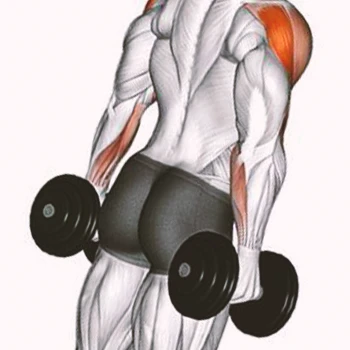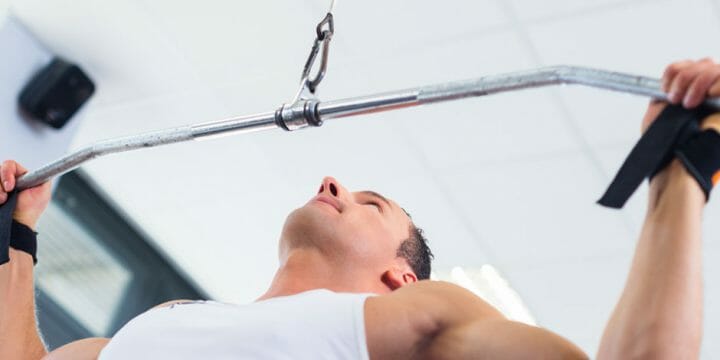The monkey row is one of those forgotten exercises that many athletes ignore because they prefer working with cable row machines or doing lateral raises.
But the simple armpit row is an excellent way to train the shoulders, especially the lateral delts.
To see if I can resurrect these armpit rows and see them back at gyms, I got a team of personal trainers together to put together this guide and show you how to get the technique right.
Let’s take a look at how to do monkey row exercises the right way.
Quick Summary
- To perform monkey rows, stand with a dumbbell in each hand, using a hammer grip, and pull the weights up under your armpits while flaring out your elbows and shrugging your shoulders.
- These exercises primarily engage the shoulder and upper back muscles, including the lateral and front deltoids, traps, and biceps.
- Strengthening the lateral and front deltoids through monkey rows, as recommended by the Cleveland Clinic, can increase arm movement and rotation by up to 20%, resulting in well-defined and rounded shoulders.
- In my opinion, monkey rows are an underrated tool in shoulder workouts, offering both muscle strengthening and potential injury rehabilitation benefits.
How To Do Monkey Row Exercises

In my coaching experience, I've seen many beginners mistakenly simplify the monkey row, also known as the upright row or dumbbell armpit row, overlooking crucial aspects of the technique.
But if you follow these instructions, you’ll get maximum value:
- Get into the starting position by standing tall with a dumbbell in each hand, holding them with a hammer grip at arm's length.
- Slowly pull the dumbbells as far up under your armpit as possible while flaring out your elbows and shrugging your shoulders.
- Before you lower back to the starting position, hold the strain for one or two seconds, and then straighten your arms again.
- A simple variation would be to do an alternating monkey row where you pull the dumbbells up one at a time.
This technique will maximize the time under tension, which can lead to better hypertrophy [1].
What Muscles Does This Exercise Work?

The monkey row exercise primarily targets the lateral and front deltoid, traps, and biceps, making it an effective compound movement for strengthening the shoulders, upper back, and arms.
One of the big advantages of such a shoulder exercise is that it’s a compound movement involving multiple joints and muscles.
Right from the starting position, you’ll feel strain in your shoulders, and here are all the muscles you’ll target:
- Lateral and front deltoid: These muscles are key to moving your arms up and rotating them, and a great definition here will give you a nicely rounded shoulder, according to the Cleveland Clinic [2].
- Traps: This is the muscle group at the upper back, and it works to assist in maintaining good posture and raising your arms up [3].
- Biceps: As you will also be bending the elbows, the monkey row will also engage the biceps, similar to bicep curls but with less strain, according to the Ken Hub [4].
Monkey rows aren't just a strength-building exercise; they have shown remarkable effectiveness in rehabilitation programs, especially for shoulder-related injuries. By incorporating monkey rows, individuals can work towards restoring strength and functionality in a controlled and effective manner.
What Are The Benefits Of Monkey Rows?
Monkey rows offer several benefits, including enhanced deltoid definition, improved upper body breadth, increased shoulder strength, and enhanced performance in various exercises.
These exercises not only target the delts but also support a range of movements, bolstering overall shoulder strength.
Regular practitioners may observe improved performance in exercises like pull-ups, lat pulldowns, and bench presses, thanks to strengthened shoulder muscles.
The adaptability of monkey rows makes them a valuable addition to diverse training regimens. Whether you're into powerlifting, bodybuilding, or general fitness, integrating monkey rows can enhance your workout routine with its distinct advantages.
“The primary function of the deltoid muscle is to move the humerus and the shoulder joint simultaneously.“
- Oluseun Olufade, MD
Sets And Reps

As a coach, I advise clients to tailor their monkey row sets and reps according to their specific fitness goals.
For toning and weight loss, opt for lighter weights with higher reps, such as three sets of 12 to 15 reps.
Conversely, for muscle building, aim for heavier weights with lower reps, like three sets of five to eight reps, ensuring the last few are challenging.
FAQs
Are Monkey Rows Effective?
Yes, monkey rows are an effective way to train the shoulder muscles. As you pull the dumbbells up, the exercise will engage your delts and traps, which should give you a much more defined upper body physique.
Are Monkey Rows Safe?
Yes, monkey rows are safe. What many people might find is that pulling up a pair of dumbbells like this adds a lot less strain to the shoulder joints. As a result, you should be able to train harder and avoid joint pain or injuries.
Prepare Before Your Monkey Rows To Boost Shoulder Gains
Now that you know how to do monkey row workouts, it’s time to plan these into your next upper body workout day.
Don’t be shy with the weight load, and see how effective this exercise will be in achieving more defined shoulder muscles.
The other thing I would recommend is adding a high-quality pre-workout to your stack:
We’ve extensively tested all of these products.
Try one to see how strength and endurance can add up over the months ahead.
References:
- https://www.ncbi.nlm.nih.gov/pmc/articles/PMC3285070/
- https://my.clevelandclinic.org/health/body/21875-deltoid-muscles
- https://www.physio-pedia.com/Trapezius
- https://www.kenhub.com/en/library/anatomy/biceps-brachii-muscle
About The Author
You May Also Like






